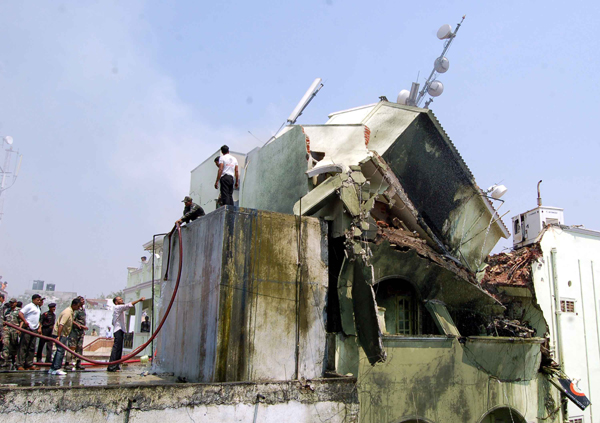|
 The IAF aerobatic team, called Surya Kiran (or Rays of the Sun in Hindi) Aerobatic Team (SKAT), is one of the few flying nine aircraft formations, and its pilots have performed daredevil aerobatics worldwide in various aerial displays and air shows, winning many laurels. The Indian Navy’s aerobatic team, designated Sagar Pawan (or Sea Breeze) Aerobatic Team (SPAT), is one of the two naval aerobatic teams in the world, the other being the US Navy’s Blue Angels which flies the F/A 18 Hornets. The IAF aerobatic team, called Surya Kiran (or Rays of the Sun in Hindi) Aerobatic Team (SKAT), is one of the few flying nine aircraft formations, and its pilots have performed daredevil aerobatics worldwide in various aerial displays and air shows, winning many laurels. The Indian Navy’s aerobatic team, designated Sagar Pawan (or Sea Breeze) Aerobatic Team (SPAT), is one of the two naval aerobatic teams in the world, the other being the US Navy’s Blue Angels which flies the F/A 18 Hornets.
Nonetheless, Kiran is of an old vintage design, and needs to be replaced with modern trainers, particularly as the hostile environment around India is bound to have the sophistication of the 4.5 or 5th Generation aircraft within the next 5 to 10 years.
IAF and Navy have used the Kiran for nearly three decades now, and in an aerobatic display, all the mechanical components as well as the aircraft frame have to be pushed to their limits. Also, older designs do not have the facility of easy checks by computers and problems can sometimes remain undetected.
According to Air Marshal Ashok Goel (Retd), a former Inspector General of Air Safety of the Indian Air Force (IAF), a technical fault, pilot disorientation, or a bird hit, could be the cause of the crash. But the truth could be ascertained only after an examination of the aircraft debris.
IAF has suffered two air crashes during aerobatics at its training academy in Bidar, located some 160 km from Hyderabad in the neighbouring Indian state of Karnataka. (Hyderabad is in Andhra Pradesh).
Notably, the Indian Armed Forces also lack the absolute basic ab initio trainer. The basic propeller-driven trainer, on which pilots make the beginning of their flying career, is the HAL made HPT 32 Deepak (or light), which has become notorious for extinguishing lives of both the instructors and trainees. All flying on it was stopped after two instructors died on 31 July 2009.
With the grounding of HPT 32 Deepak, pilots are being given initial training straightway on Kiran jets, something which should not normally be done but the IAF and Navy have no choice, thanks to the persistent delay in replacing the ill-reputed aircraft.
Although IAF has now acquired Hawk Advanced Jet Trainers (AJTs) – BAE Systems’ Hawk 132 – the lack of a good basic trainer is going to tell on the capability of future pilots who have to cope up with the rapidly-changing environment of ultra modern hi-tech aircraft in the next five to 10 years.
IAF had contracted 66 Hawks from BAE Systems, of which 24 came in flyaway condition. Of the remaining 42, which were to be assembled/ partly made in India with kits and some indigenous components, less than 10 have been supplied by HAL against a target of 20-plus by March 2010. Training is also suffering on this account.
IAF floated a worldwide Request for Proposals
(RfP), or tender, in December 2009 for 75 basic
trainers with another 106 to be made in the country
by HAL under Transfer of Technology (ToT). Meanwhile,
efforts are also being made to rectify the fault
in the fuel supply system of the HPT 32’s
Lycoming engine.

Observes one retired IAF instructor: The HPT 32 can start and fly perfectly, but midair, without any reason, its fuel supply chokes. And in an instant, the aircraft can start again, or maybe just fall. Both the IAF and Navy have had to cut down on the required flying hours for trainee pilots and solo missions because of this.
It takes five years to train a pilot to enable him to operate combat missions by himself. Due to the shortage of basic trainers and AJTs, there are serious concerns in the Armed Forces over the quality of training.
As for the Navy, it is still without the AJT also, despite its acquisition of new Mig 29Ks and plans for a newer generation of aircraft in the coming years.
The government needs to fast-track the requirements of the IAF, Navy, Army and Coast Guard in this regard.
According to noted defence analyst C Uday Bhaskar, the material state of the (aircraft) fleet across the board with Indian Armed Forces “is a cause for deep concern.”
“The number of AJTs is far short of what had been sought and as far as the Navy is concerned, its original request for an AJT is still to be realized. Hence the Kiran remains the workhorse for the Indian Navy.”
|